Winter always brings cold, snow, and a yearning for spring. But for us it also comes with questions from both old and new customers about their unexpectedly high electricity bills. Truth is, there is always a reason; the issue is just ferreting it out.
Seasonal Impacts
In winter the days are shorter, the sun is lower in the sky, and we tend to have worse weather. But how much does that really matter? Well, a lot. Your January production is roughly half of July’s! You can see a typical roof’s monthly production profile here (we also include these in most of our proposals).
Worse still, winter tends to bring an increase in electrical rates. This has two impacts. First, the power your system can’t cover with production or carry over credits costs more. But a harder to see impact is how that works out with net metering credits. You see, credits you earn in the summer are converted to a monetary value. So if the summer rate is 20 cents a kW hour, you don’t earn one kW hour – you earn 20 cents in credit. So if the winter rate jumps to say 24 cents and you’re using credits from the summer it takes more credits to pay for each kW hour you are using. It’s still great to be shifting your summer production to the winter, but that price difference can be a bit of a bummer.
Last, there is the fact that we’re all human. And particularly when your system is new it is very common to kind of let your electricity use get out of hand. After all, you’ve got solar! In fact, it is not atypical for us to see people using 10% to 20% more than they had in the past. The good news is it is generally pretty easy to go back to how you used power in the past. Sure, the power you produce is cheap and already paid for – but it still pays to pay attention to what ultimately is a finite resource.
New England Clean Energy Tip
Things can sometimes go wrong with solar, particularly when they are newer (electronics tend to have a break in period). So it is smart to check your monitoring regularly. But not all bad production days are due to a problem. It could just be the weather. Before you panic, check the weather back on that low day (or even days). One great site is DarkSky.com. Find your location and then scroll down to the “Time Machine” button. That will let you find detailed weather for any day in the past, even hour by hour. It’s not a perfect measure, but the precipitation and UV Indexes will be your best guide to good and bad days for solar.
